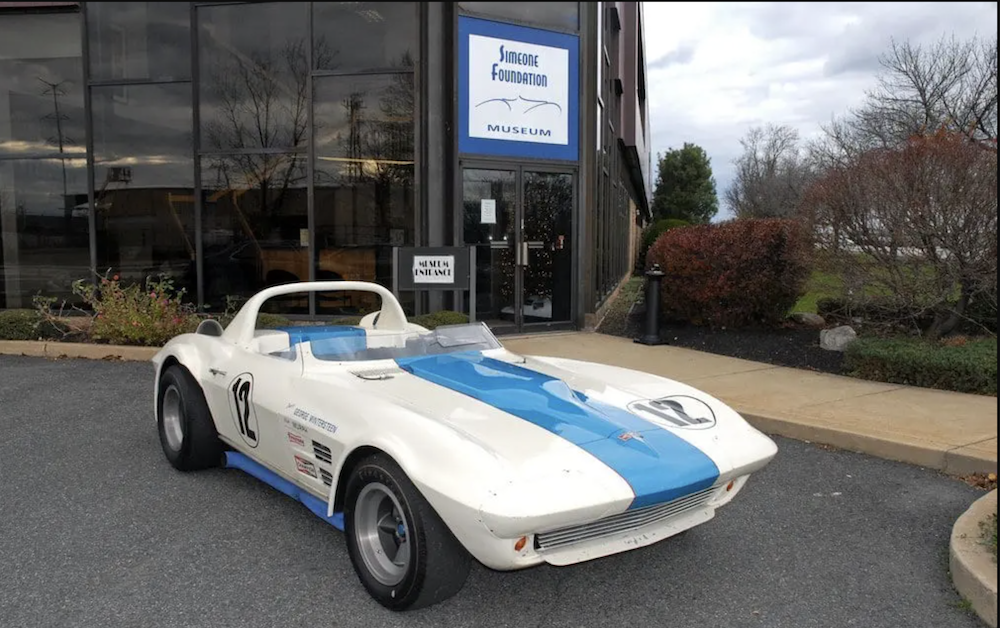Hidden Gem: The Only Original, Unrestored 1963 Grand Sport

Take a glimpse at the only unrestored Grand Sport – GM’s final answer to the Cobra, and why this car was so pivotal in racecar restoration.
Hidden away in the Simeone Foundation Automotive Museum in Philadelphia, posed alongside a 1950 Allard J2, sits an invaluable piece of Corvette history. Purchased by Jim Jaeger in 1990, the car in question is the only original, unrestored 1963 Grand Sport in existence. Of the five vehicles produced, this one’s the only example still bearing the original battle scars of its short-lived racing career in the mid-60s. And even among the fellow contemporary original race cars on display, this car’s history stands out. Not because of its accolades on track (though yes, it was very fast). But because of its contributions to the art of restoration.
The Birth of the Grand Sport

The origins of the Grand Sport lay in 1959, through the end of official factory-backed teams and the XP-87 Stingray race car, discussed in-depth here. Itself a development of the 1957 Corvette SS, the Stingray served as the basis of the C2 that followed. The car enjoyed a brief but successful stint, winning the 1960 SCCA Championship before retirement. Meanwhile, in the same year, Carroll Shelby began asking around with plans to build a lightweight V8 sports car. By January 1962, his plans materialized into the first Shelby Cobra. And it was fast. So fast that Zora Duntov, drawing inspiration from the XP-87, hastily designed a new iteration of this classic race car. Combining the best characteristics of the Corvette racers with the updates of the roadgoing C2, the Grand Sport was born in MY 1963.
Duntov initially intended for the Grand Sport’s homologation into production categories, requiring 125 examples. However, GM axed factory-backed racing, and only five cars were built. Each of them is totally unique from one another, though they do have some commonalities. But in general, they represented the absolute pinnacle of racing Corvettes, driven by such names as Roger Penske, Jim Hall, and Dick Thompson, among others. This example is Chassis #002, equipped with an all-aluminum 7.0L V8 produced by Traco Engineering out of Culvert City, California.
Having Your Cake and Eating It, Too

As mentioned before, Grand Sport 002 is unique in that it’s the only totally unrestored example. So, wanting to preserve the history as well as own a restored example, owner Jim Jaeger commissioned a duplicate utlizing a unique restoration technique. Essentially, he used the original body as a template, replicating hundreds of components to their exact specifications. Everything from whole body panels to nuts and bolts were machined and duplicated using a variety of innovative techniques, and every single part of the original was documented. This documentation now serves as the benchmark by which the other Grand Sport restorations were measured.
The project took several years to complete, and wound up with effectively two functioning vehicles. A 377c.i. V8 built to the original Grand Sport’s specifications powered the exact duplicate body, the true definition of the word “replica.” This accomplished two crucial objectives. Firstly, it preserved the history of the original car, now on display for the world to see. And secondly, it pioneered a restoration method that’s set the bar for original racing vehicles since.
The Grand Sport today sits in the Watkins-Glen exhibit, featuring two vehicles, itself and the Allard J2. Elsewhere in the late Dr. Frederick Simeone’s collection rests a beautiful big-block 1966 Sting Ray roadster in Laguna Blue. Which, of course, is also in original, unrestored condition. Both Corvettes are routinely exercised in the museum’s parking lot for onlookers to enjoy.
All 1963 Grand Sport images copyright Simeone Foundation Automotive Museum.





